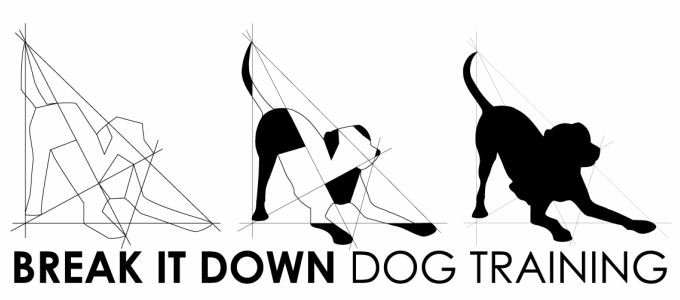
The next morning Lucy was back doing her 6:30AM alarm clock routine, but this time I decided I wasn’t going to give in to her demand, hoping she would settle back down and give me a little more sleep. After a minute of bed brushing and tail thwapping while I pretended to still be asleep, I watched Lucy back up ten feet and, to my surprise and amusement, she raced forward and full on body slammed into the bed. She then looked at me for any response, only to see somehow I had not noticed the 7.8-magnitude earthquake she had created. Lucy then circled around a bit, walked back over to her bed, and laid down with the loudest doggie groan of defeat I have ever heard.
As I am sure many of you know from first-hand experience, dogs are extremely clever when it comes to figuring out how we behave. If we aren’t mindful of how our actions are continually being monitored and conditioned by our dogs, we can quickly find ourselves in a place where our dog learns to control us. Like Lucy manipulating her owners out of bed, dogs can learn that many of their behaviors elicit specific responses from their humans. The most common of these are impulsive behaviors: barking, whining, jumping, biting/mouthing. If a bored dog barks and a human turns their direction, simple. “Barking gets humans to look at me.” How often have you seen a dog at the dog park shove a ball towards their human and immediately start barking their head off? To stop the barking, her human quickly gives in and throws the ball. “Perfect," she'll realize, "barking makes the human throw the ball -- I shall do that from now on!”
Sometimes teaching our dogs tricks can backfire. Teaching and rewarding a dog to “shake” often will result in that dog (cleverly) trying out that awesome new behavior in other contexts. She may, for example, come over while you are reading, place her paw up on your hand, and before you realize what you are doing, you are looking at her, smiling, thinking how adorable she is as you had just practiced shake that morning, and then you engage in petting or play. Guess what? Your dog now knows the thing that can magically transform you from a boring book reader to an engaging play partner! “Man, humans are so easy!” she’ll think to herself.
Another common mistake people make is reprimanding an attention-seeking/demanding dog, either by verbal instruction or physical force (ie. yelling, “Quiet!” at a barking dog, pushing a jumping dog off your legs, etc.). For most dogs, giving any kind of attention, even if it is negative, can be enough to reinforce the attention-seeking behavior. It's best to just ignore the demanding behavior.
So how do we stop our dogs from learning to demand things from us? The solution is relatively simple. If your dog is behaving in a way you suspect is to elicit something from you, think:
1. What does my dog want?
2. Am I doing something that reinforces her behavior?
3. Can I control or withhold giving her what she wants?
4. Is there a better behavior I would like her to do when she wants this thing?
Let’s consider the ball-crazed barking dog. If you are holding a ball in your hand and your dog is barking at you, it is pretty darn apparent what she wants (spoiler: she wants you to throw the ball). With that ball in your hand, however, you control everything. Realize that the moment you throw the ball, you are reinforcing the current behavior your dog is in. So, while your dog is barking, do the thing she does not anticipate: wait. Eventually, your dog will begin to figure out that barking no longer makes you throw the ball. Before this happens, however, most dogs will actually increase the level of their demand. Remember Lucy’s 7.8-magnitude body slam from earlier? A demand-barking dog will think, “Strange, my normal barking that usually works is no longer working. Perhaps if I bark louder it will work again.” Don’t give in, my friends! If you cave during this escalation process, your dog will have a new baseline to begin her demand for next time. If you can patiently wait long enough, she will stop barking. As soon as she stops barking, you give her what she’s been wanting the entire time (hint: throw the ball now!). Congratulations, you have just reinforced silence! Take this another step and patiently wait until your dog sits (without barking) before you throw the ball. So long as you are not instructing her to sit, she will consider sitting as the new way to demand that you throw the ball. A polite, demanding dog, who knew?
With enough practice, your dog will automatically begin to practice politely demanding things from you. Keep your trainer hat on whenever you are around your dog, and always be considering the relationship between the things you do and how your dog is learning to react around them. As you do, she will begin to generalize patience, politeness, and impulse control in every aspect of her life.
Training Protip: you can turn some behaviors your dog does normally into routine methods of communication. Ex. You know it’s around the time your dog typically needs to the bathroom, and she happens to walk towards the back door, respond by saying, “Good girl! Let’s go out!” and lead her to the potty area. Over time (re: repetition), she will learn that walking towards the back door will cause the human to open the door to the potty area.
Additional Note: If you have a dog who is shy or fearful of people, do not discourage attention-seeking behaviors! Your goal in helping your pup overcome her fears is to make every human interaction a positive one. Imagine a shy dog learning she can paw someone for petting. Not only does this build confidence in her actions, but allows the attention to be on her terms!

 RSS Feed
RSS Feed